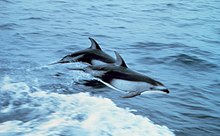
Back دلفين محيطي Arabic دلفين محيطى ARZ Delphinidae AST Yaburol (Delphinidae) AVK Дэльфінавыя BE-X-OLD Делфинови Bulgarian শুশুক Bengali/Bangla Delphinidae Breton Далайн гахай BXR Delfínids Catalan
| Oceanic dolphin Temporal range:
| |
|---|---|

| |
| Pacific white-sided dolphins | |
| Scientific classification | |
| Domain: | Eukaryota |
| Kingdom: | Animalia |
| Phylum: | Chordata |
| Class: | Mammalia |
| Order: | Artiodactyla |
| Infraorder: | Cetacea |
| Superfamily: | Delphinoidea |
| Family: | Delphinidae Gray, 1821 |
| Type genus | |
| Delphinus | |
| Genera | |
|
See text. | |
Oceanic dolphins or Delphinidae are a widely distributed family of dolphins that live in the sea. Close to forty extant species are recognised. They include several big species whose common names contain "whale" rather than "dolphin", such as the Globicephalinae (round-headed whales including the false killer whale and pilot whale). Delphinidae is a family within the superfamily Delphinoidea, which also includes the porpoises (Phocoenidae) and the Monodontidae (beluga whale and narwhal). River dolphins are relatives of the Delphinoidea.
Oceanic dolphins range in size from the 1.7-metre-long (5 ft 7 in) and 50-kilogram (110-pound) Maui's dolphin to the 9.4-metre (31 ft) and 10-metric-ton (11-short-ton) orca, the largest known dolphin. Several species exhibit sexual dimorphism; the males are larger than females. They have streamlined muscular bodies and two limbs that are modified into flippers. Though not quite as flexible as seals, some dolphins can travel at speeds 29 km/h (18 mph) for short distances.[1] Most delphinids primarily eat fish, along with a smaller number of squid and small crustaceans, but some species specialise in eating squid, or, in the case of the orca, also eat marine mammals and birds. All, however, are purely carnivorous. They typically have between 100 and 200 teeth, although a few species have considerably fewer. Delphinids travel in large pods, which may number a thousand individuals in some species. Each pod forages over a range of tens to hundreds of square kilometres. Some pods have a loose social structure, with individuals frequently joining or leaving, but others seem to be more permanent, perhaps dominated by a male and a harem of females.[2] Individuals communicate by sound, producing low-frequency whistles, and also produce high-frequency broadband clicks of 80–220 kHz, which are primarily used for echolocation. Gestation lasts from 10 to 18 months, and results in the birth of a single calf. Some species are well adapted for diving to great depths. They have a layer of fat, or blubber, under the skin to keep warm in the cold water.
Although oceanic dolphins are widespread, most species prefer the warmer waters of the tropic zones, but some, like the right whale dolphin, prefer colder climates. Some have a global distribution, like the orca. Oceanic dolphins feed largely on fish and squid, but a few, like the orca, feed on large mammals, like seals. Male dolphins typically mate with multiple females every year, but females only mate every two to three years. Calves are typically born in the spring and summer, and females bear all the responsibility for raising them. Mothers of some species fast and nurse their young for relatively long times. Dolphins produce a variety of vocalizations, usually in the form of clicks and whistles.
Oceanic dolphins are sometimes hunted in places such as Japan, in an activity known as dolphin drive hunting. Besides drive hunting, they also face threats from bycatch, habitat loss, and marine pollution. Dolphins have been depicted in various cultures worldwide. They occasionally feature in literature and film, as in the Warner Bros film Free Willy. Dolphins are sometimes kept in captivity and trained to perform in shows. The most common species of dolphin in captivity is the bottlenose dolphin, and less than 50 orca were found in oceanariums in 2012.
- ^ Grady, John M.; Maitner, Brian S.; Winter, Ara S.; Kaschner, Kristin; Tittensor, Derek P.; Record, Sydne; Smith, Felisa A.; Wilson, Adam M.; Dell, Anthony I.; Zarnetske, Phoebe L.; Wearing, Helen J. (2019-01-24). "Metabolic asymmetry and the global diversity of marine predators". Science. 363 (6425): eaat4220. doi:10.1126/science.aat4220. ISSN 0036-8075. PMID 30679341. S2CID 59248474.
- ^ Cite error: The named reference
EoMwas invoked but never defined (see the help page).
© MMXXIII Rich X Search. We shall prevail. All rights reserved. Rich X Search